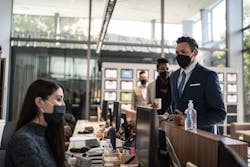Managing Corporate Security in the Pandemic Age
While many people around the country were under stay-at-home orders, security professionals, classified by the federal government as “essential personnel”, continued to report to work during the pandemic. The heart and soul of the physical security industry are the nation’s contract security professionals who assume leadership roles – sometimes with lifesaving ramifications – at facilities across the country. security professionals can act as the first line of defense against civil unrest, violence, terrorist attacks and the pandemic.
Today’s security professional is a highly trained individual with access to cutting-edge technology that connects artificial intelligence and human response to better protect people with accurate real-time data and safer social interaction.Working during a pandemic can be fraught with tension as we all navigate this new terrain. The Occupational Safety and Health Administration (OSHA) and The Centers for Disease Control (CDC) recommend social distancing procedures, regular disinfection and sanitation, and foot traffic management.
Getting Back to the Workplace (Safely)
The pandemic has accelerated technological change in corporate America. Many employers required employees to work from home during the heart of the pandemic. Today, with millions being vaccinated daily and states rolling back pandemic restrictions, more Americans are returning to the workplace.
Security professionals are working with corporate leaders to design and implement a variety of screening services to ensure the health and safety of employees. These solutions must best fit their environment, requirements and existing security operations.
Preparedness programs are now ‘de rigueur’ in corporate America. Hence, if another pandemic should happen, more employers will be prepared and won’t have to shut down their facilities. Employers are ensuring their workplace maintains social distancing protocols. They continue temperature screening solutions, they utilize frictionless access control, they ensure the sanitization and disinfection of common and high traffic areas, and they have stocked up on personal protective equipment (PPE).
Corporate security is helping plan for business continuity. They are communicating the pandemic/epidemic plan to all employees and ensuring they are trained on it. They are establishing a continuity plan for employee absenteeism, considering flexible schedules or telecommuting, utilizing teleconferencing or online meetings in place of large, in-person gatherings, canceling non-essential travel to areas affected by an outbreak, compiling contact information for employees’ emergency contacts, clients, the public health department and police/fire/paramedics, having masks, gloves and cleaning agents available on-site, monitoring news coverage and public health information, and encouraging employees who are ill to stay out of the workplace.
When determining which access control and temperature screening applications will be most effective, companies are working with their security partner to determine the number of access points that require screening, traffic flow requirements, and the level of integration desired that is feasible with existing systems.
Utilizing thermal cameras with associated artificial intelligence software and equipment, Security Professionals are using advanced distance screening technology. Distance screening technology includes mounted imaging kiosks which include specialized cameras integrated directly with artificial intelligence technology that analyzes and compares data against predefined parameters.
High-traffic distance screening technology also includes walk-through temperature sensors with built-in cameras that detect apparent temperatures of people by reading the energy emitted from the subject’s surface. Hot spots can indicate a fever or underlying infection. These analytics take multiple images in less than a second to ensure that the hottest spot is captured from multiple images if the person moves during image capture.
COVID-19’s Operational Impact on Critical Infrastructure
With corporate security a cost center, it can be a challenge to get funding and innovate at the same pace as the industry. However, everything that has happened with the pandemic has catapulted corporate security and their organizations to embrace innovation and new technology. This movement to innovation is resulting in an acceleration of manned guarding’s convergence with technology.
As corporate security looks to drive down costs, they are turning to Monitoring and Response Centers (MaRC), which provide video monitoring as a service with complete end-to-end security solutions, including cameras, access control, traditional alarms and remote audio features. By leveraging video analytics with real-time, event-based monitoring, companies are force multiplying and optimizing their existing security force while enhancing day-to-day security operations. With facilities not as occupied as pre-pandemic, incurring after-hours security professionals may be outside the budget. However, when corporate security integrates with a MaRC, the monitoring is 24/7 and if any suspicious activity is discovered, or someone needs help, a security professional or law enforcement officer is immediately dispatched.
Security professionals are today’s ‘CARE Ambassadors’ who provide a friendly and welcoming presence to help ease return-to-workplace anxieties. They are disseminating hand sanitizer, conducting thermal body temperature screening, encouraging PPE compliance and navigating employees through new no-touch access control and card readers.
With artificial intelligence (AI)-powered workflows, there is real-time communication with security officers who are receiving messages remotely with important updates or tasks. AI-powered workflow guides security teams through processes to ensure that site-specific post orders are met. For example, checking sanitation stations hourly or verifying that PPE supplies are in stock. With real-time visibility and reporting, whether onsite or remote, corporate security is able to ‘follow along’ with their security team for complete transparency.
Thinking Outside-the-Box to Keep Everyone Safer
The security sector’s increasingly sophisticated technology offers more opportunities for security system enhancements and program integration than ever before. A great advance in the sector is the burgeoning role of augmented technology - autonomous data machines (ground-based ADMs or robots) and drones (UAVs - Unmanned aerial vehicles) - that are purposely built for security programs seeking to increase threat awareness and management through the strategic integration of people, processes and technology.
Threats, crime and disruption do not operate on a timetable, nor do they sleep. Drones and robots provide 24/7 autonomous patrolling and monitoring including automatic recharging without human intervention so that a company’s assets can be secure 24/7. Some facilities use drones or robots for perimeter security patrols, which provide “smart eyes and ears'' that enable security personnel to do their job more effectively. Companies are benefiting from the extra bells and whistles concerning access control that this sophisticated technology provides.
Today’s security professional is trained to implement a variety of safety and health screening services. Security professionals are also working with their clients to design and implement screening solutions that best fit the environment, requirements and existing security operations. State-of-the-art technology that connects artificial intelligence and human response to better protect people with accurate real-time data and safer social interaction is becoming the ‘gold standard in our industry.
About the Author

John Bradford
Senior Vice President, Sales at Allied Universal® Technology Services
John Bradford is Senior Vice President, Sales at Allied Universal® Technology Services. Allied Universal, a leading global security and facility services company, employs more than 800,000 people with $18 billion in revenues. Additional information is available at www.aus.com. John can be reached at [email protected].


